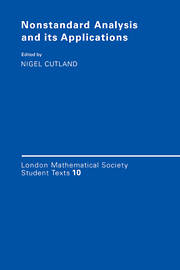Book contents
- Frontmatter
- Contents
- Preface
- Contributors
- AN INVITATION TO NONSTANDARD ANALYSIS
- INFINITESIMALS IN PROBABILITY THEORY
- INFINITESIMALS IN FUNCTIONAL ANALYSIS
- APPLICATIONS OF NONSTANDARD ANALYSIS IN MATHEMATICAL PHYSICS
- A LATTICE FORMULATION OF REAL AND VECTOR VALUED INTEGRALS
- AN APPLICATION OF NONSTANDARD METHODS TO COMPUTATIONAL GROUP THEORY
- SYNTACTICAL METHODS IN INFINITESIMAL ANALYSIS
- SOME ASYMPTOTIC RESULTS IN ORDINARY DIFFERENTIAL EQUATIONS
- SUPERINFINITESINALS AND INDUCTIVE LIMITS
- THE NON-LINEAR BOLTZMANN EQUATION FAR FROM EQUILIBRIUM
- INDEX
INFINITESIMALS IN FUNCTIONAL ANALYSIS
Published online by Cambridge University Press: 05 June 2012
- Frontmatter
- Contents
- Preface
- Contributors
- AN INVITATION TO NONSTANDARD ANALYSIS
- INFINITESIMALS IN PROBABILITY THEORY
- INFINITESIMALS IN FUNCTIONAL ANALYSIS
- APPLICATIONS OF NONSTANDARD ANALYSIS IN MATHEMATICAL PHYSICS
- A LATTICE FORMULATION OF REAL AND VECTOR VALUED INTEGRALS
- AN APPLICATION OF NONSTANDARD METHODS TO COMPUTATIONAL GROUP THEORY
- SYNTACTICAL METHODS IN INFINITESIMAL ANALYSIS
- SOME ASYMPTOTIC RESULTS IN ORDINARY DIFFERENTIAL EQUATIONS
- SUPERINFINITESINALS AND INDUCTIVE LIMITS
- THE NON-LINEAR BOLTZMANN EQUATION FAR FROM EQUILIBRIUM
- INDEX
Summary
The aim of this article is to provide, when combined with the survey paper Henson & Moore (1983), a fairly complete description of the nonstandard hull construction and of the most important ways in which nonstandard methods have been used to solve problems in functional analysis. Most of the material concerning Banach spaces is already covered in that earlier survey; there are a few important recent developments, which we have included in the last two sections of this paper. Here we will, however, concentrate on the general nonstandard hull construction for topological vector spaces and for operators on such spaces. We have also tried to include here some more elementary variations on arguments which appeared there, and it may well be that this paper can in part serve as an introduction to the Banach space survey. (But also the reverse may be true for some readers.)
The nonstandard hull construction applied to topological vector spaces and to continuous operators on them plays very much the same role in functional analysis that the Loeb measure construction does in probability theory. It provides a systematic (functorial) procedure for obtaining a topological vector space or continuous operator (in the usual mathematical sense) from internal spaces and operators. Moreover, in the setting of functional analysis there is an elaborate and important structure of infinitesimals and finite points, which provide an elegant framework for the expression of complicated topological concepts, as well as for the study of the nonstandard hulls themselves.
- Type
- Chapter
- Information
- Nonstandard Analysis and its Applications , pp. 140 - 181Publisher: Cambridge University PressPrint publication year: 1988
- 2
- Cited by



